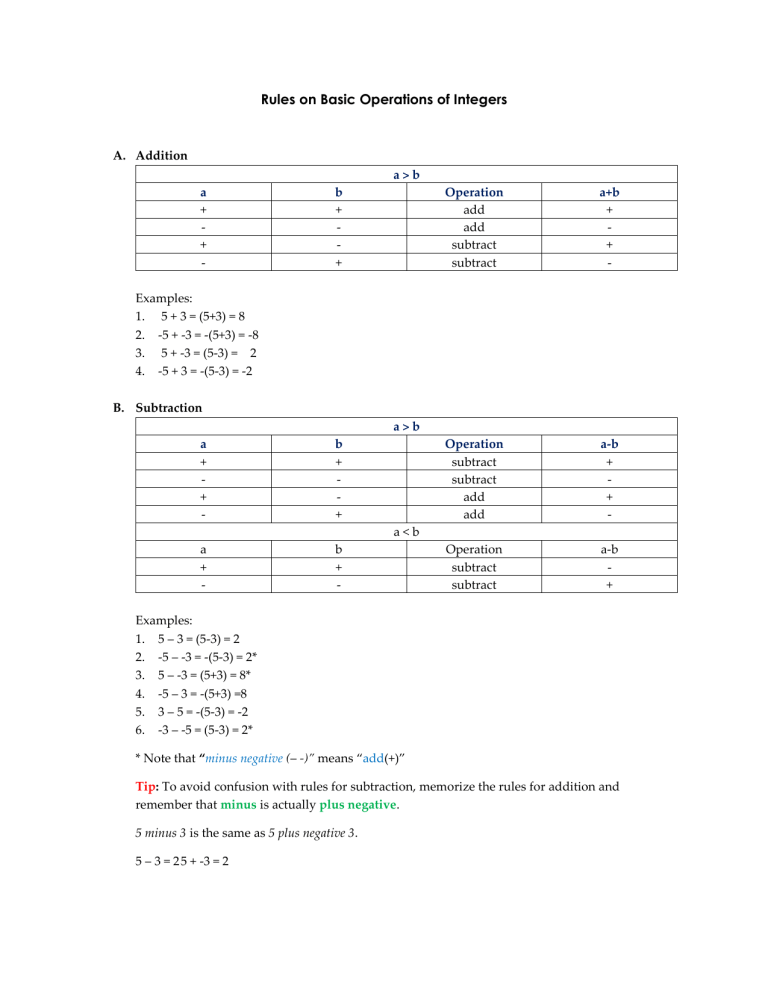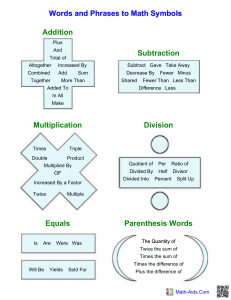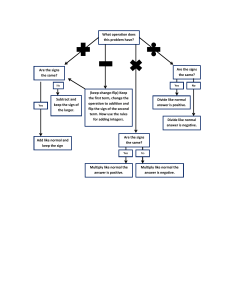
Rules on Basic Operations of Integers A. Addition a>b a + + - b + + Operation add add subtract subtract a+b + + - Operation subtract subtract add add a-b + + - Operation subtract subtract a-b + Examples: 1. 5 + 3 = (5+3) = 8 2. -5 + -3 = -(5+3) = -8 3. 5 + -3 = (5-3) = 2 4. -5 + 3 = -(5-3) = -2 B. Subtraction a>b a + + - b + + a<b a + - b + - Examples: 1. 5 – 3 = (5-3) = 2 2. -5 – -3 = -(5-3) = 2* 3. 5 – -3 = (5+3) = 8* 4. -5 – 3 = -(5+3) =8 5. 3 – 5 = -(5-3) = -2 6. -3 – -5 = (5-3) = 2* * Note that “minus negative (– -)” means “add(+)” Tip: To avoid confusion with rules for subtraction, memorize the rules for addition and remember that minus is actually plus negative. 5 minus 3 is the same as 5 plus negative 3. 5 – 3 = 2 5 + -3 = 2 C. Multiplication a + + b + - Operation multiply multiply multiply ab + + - In multiplication, regardless of which number is larger, the general rule is that the product of two numbers with the same sign is always positive. Example 1. 5 x 3 = 15 2. -5 x -3 = 15 3. -5 x 3 = -15 4. 5 x -3 = -15 D. Division a + + b + - Operation divide divide divide ab + + - Similar with multiplication, the rules for division is the same since division is actually multiplying one number by the reciprocal of the other. a/b = a(1/b) Examples: 1. 15/3 = 5 2. -15/-3 = 5 3. -15/3 = -5 4. 15/-3 = -5 E. Operations with 0. a. 0 + x = x x+0=x Adding a number to zero and adding zero to a number will have the number as the answer. 0+3=3 3+0=3 b. 0 – x = -x x–0=x Subtracting a number from zero will yield a negative answer. However, subtracting zero from a number will yield the original number. 0 – 3 = -3 3–0=3 c. (x)(0) = 0 (0)(x) = 0 All numbers multiplied by or to zero is always equal to zero. 3x0=0 0x3=0 d. 0/x =0 x/0 = undefined Dividing zero will always yield zero. However, dividing a number by zero is a mathematical error and undefined. 0/3 =0 3/0 = undefined


